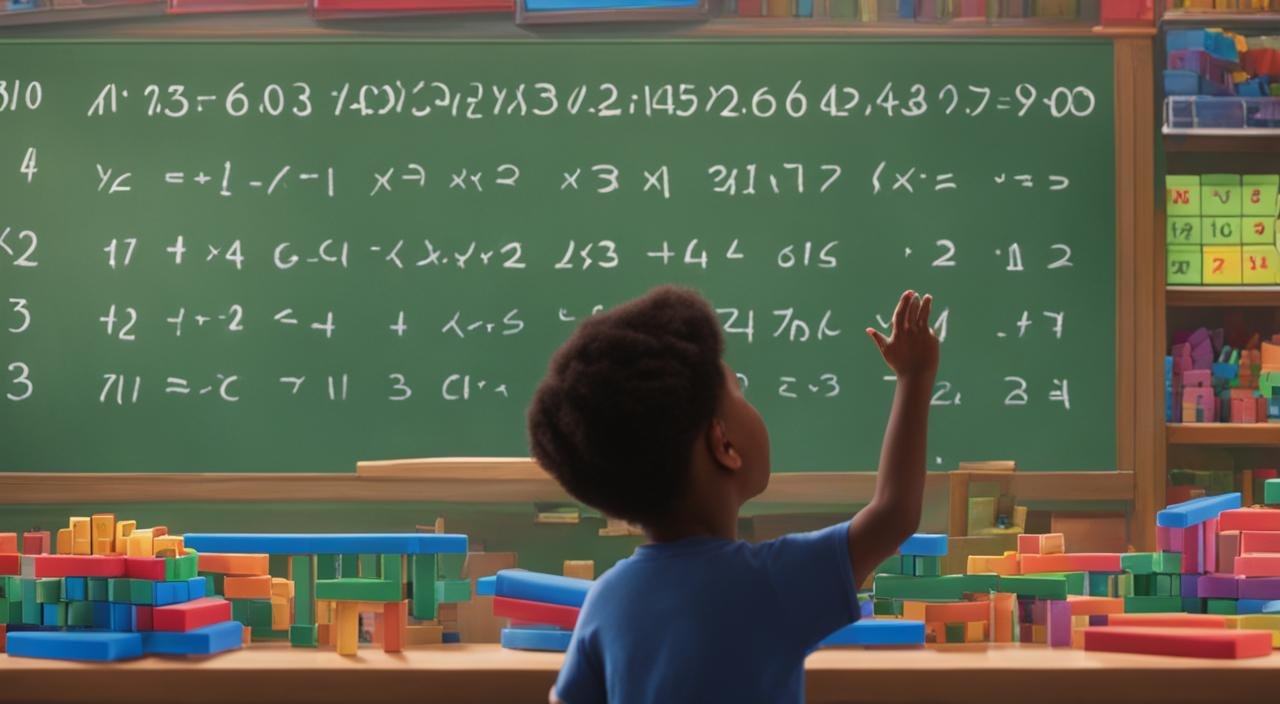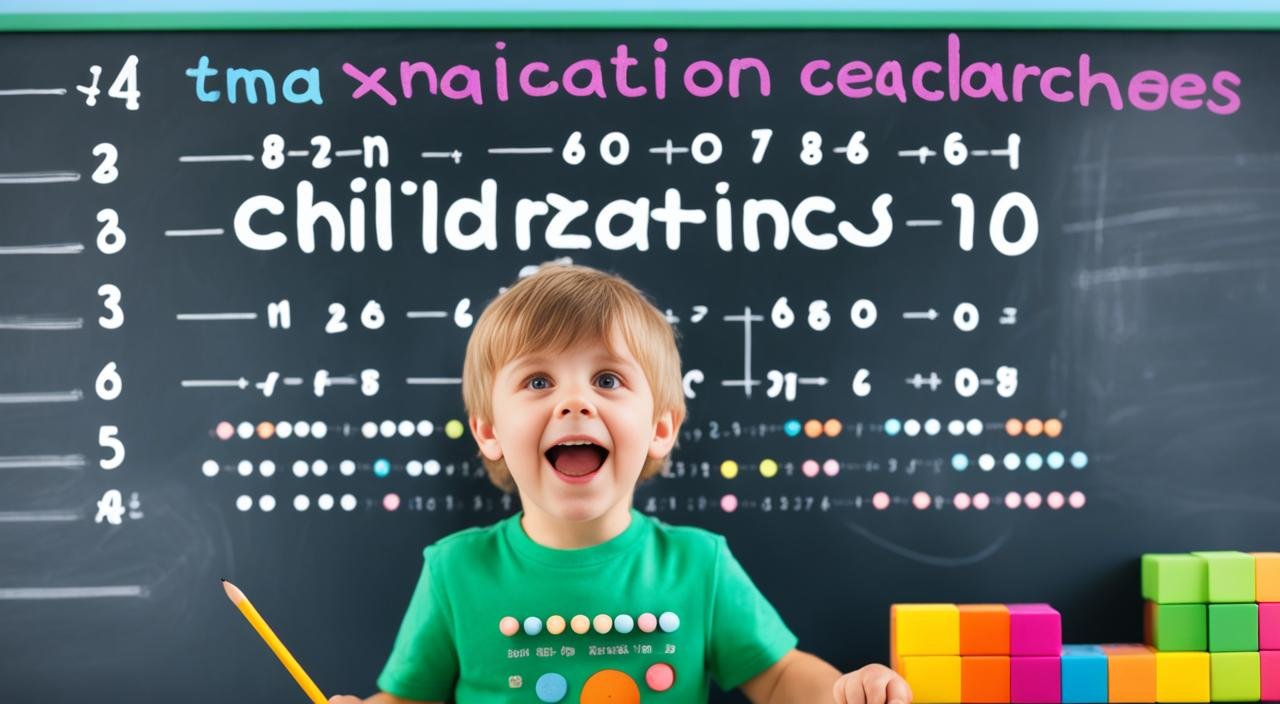As parents and educators, we understand the unique challenges that come with teaching a child with autism. We know the importance of patience, adaptability, and finding the right approach to help them learn and thrive. When it comes to teaching multiplication to an autistic child, it’s crucial to tailor our strategies to their specific needs and abilities.
Whether you’re a parent, teacher, or caregiver, you play a pivotal role in unlocking the potential of these incredible children. By understanding the best techniques for teaching multiplication and incorporating them into their learning journey, you can empower them to develop essential math skills and build a strong foundation for future learning.
Key Takeaways:
- Start with concrete examples and visual aids to help autistic children understand the concept of multiplication.
- Break down complex concepts into smaller, manageable steps to prevent overwhelm and promote gradual learning.
- Utilize technology such as educational apps and online resources designed for children with special needs.
- Teach multiplication facts in a structured and organized manner, starting with the zero series and progressing gradually.
- Incorporate music and songs into the learning process to enhance memorization and engagement.
Start With Concrete Examples
When teaching math to an autistic child, it is essential to begin with concrete examples. Autistic children often struggle with understanding abstract concepts, making it challenging for them to grasp multiplication skills. By using visual aids such as blocks, beads, or an abacus, you can provide a tangible representation of how numbers combine to form a product.
Concrete examples create a visual connection between numbers and their outcomes, making it easier for autistic children to comprehend and memorize multiplication facts. This hands-on approach helps bridge the gap between abstract mathematical concepts and the real world, facilitating a deeper understanding of multiplication.
Whether it’s arranging blocks to represent groups of numbers or using beads to demonstrate repeated addition, these concrete examples engage multiple senses and facilitate a more comprehensive learning experience. By incorporating tactile and visual elements, you can provide the necessary support for autistic children to develop their multiplication skills.
Break Down Complex Concepts into Smaller Steps
Teaching multiplication to an autistic child can be a challenging task. Autistic children often find it overwhelming to learn multiplication as a whole concept. The key to their successful understanding lies in breaking down complex concepts into smaller, more manageable steps.
By introducing one step at a time and providing ample practice before moving on to the next step, we can support and nurture their learning process. This approach allows autistic children to focus on mastering each step, building their knowledge and confidence gradually.
Breaking down complex multiplication concepts into smaller steps not only helps autistic children better understand the process but also prevents confusion and frustration. It allows them to make connections between numbers and operations, leading to a solid foundation for further learning.
For example, to teach the concept of multiplication, start by explaining the idea of repeated addition. Show them how adding the same number multiple times leads to a bigger number.
“Let’s say we have 2 apples. If we add 2 more apples, we have a total of 4. If we add another 2 apples, we have 6. Can you see how each time we add the same number, the total gets bigger? That’s multiplication!”
Once they grasp the concept of repeated addition, you can gradually introduce the multiplication symbol and teach them how to write and read multiplication equations. Reinforce this learning by providing plenty of opportunities for practice and repetition.
Incorporating visual aids, such as charts or manipulatives, can further enhance their understanding. These aids can help autistic children visualize the process and better comprehend how numbers interact with each other to create a product.
Remember, the goal is to support and guide autistic children as they learn multiplication at their own pace. By breaking down complex concepts into smaller steps and providing ample practice, we can effectively teach multiplication to autistic children and help them thrive in their mathematical journey.
Key Takeaways:
- Break down complex multiplication concepts into smaller, more manageable steps.
- Introduce one step at a time and provide ample practice before moving on.
- Use visual aids to enhance understanding and visualization.
- Reinforce learning through repetition and practice.
- Support autistic children’s learning at their own pace.
Utilize Technology
Technology can be a powerful resource when teaching multiplication to autistic children. There are various apps and online platforms specifically designed to engage and support the learning of children with special needs. By incorporating interactive games and activities, you can make the process of learning multiplication more enjoyable and effective.
Explore different technological tools that align with the child’s interests and learning style. These resources can provide a dynamic and interactive learning experience tailored to their needs. By using technology, you can create a stimulating environment that fosters engagement and enhances their understanding of multiplication concepts.
One valuable technological tool is the use of interactive games. These games not only make learning multiplication fun but also provide opportunities for repeated practice, allowing children to reinforce their understanding. Additionally, there are online resources that offer step-by-step tutorials and visual representations to support the learning process.
| Benefits of Using Technology for Teaching Multiplication | Examples of Technological Resources |
|---|---|
| Engaging and interactive learning experienceVisual representations aid in comprehensionOpportunities for repeated practiceIndividualized learning approach | Khan AcademyProdigyMultiplication.comMath Playground |
By utilizing technology, you can provide a unique learning experience that caters to the specific needs and preferences of autistic children. Remember to assess the child’s individual strengths and interests to find the most suitable technological resources for their learning journey.
Teach Them in Order First

Autistic children often benefit from an organized and structured approach to learning. When it comes to teaching multiplication, starting with a systematic order can help them grasp the concept more effectively. By introducing multiplication facts in consecutive order, you can provide autistic children with a solid foundation before moving on to more complex equations.
Begin with the zero series, which includes basic addition equations such as 0+0, 0+1, 0+2, and so on. This initial focus on zero sets the stage for understanding the fundamental concept of multiplication, where any number multiplied by zero equals zero.
“By teaching multiplication facts in an orderly manner, we allow autistic children to build their understanding step by step, creating a strong mathematical foundation.”
As the child becomes comfortable with the zero series, gradually progress to higher numbers. Introduce the one series (1+1, 1+2, 1+3, etc.) and continue moving up the ladder. This sequential approach helps autistic children develop a clearer understanding of how numbers combine and multiply, making it easier for them to transition to more complex multiplication facts.
By teaching them in order first, you are providing autistic children with a structured learning experience that promotes comprehension and confidence. This method ensures that they lay a solid mathematical groundwork, enabling them to tackle more challenging multiplication concepts in the future.
Engaging Visual:
| Series | Examples |
|---|---|
| Zero Series | 0+0, 0+1, 0+2, 0+3, 0+4, 0+5, 0+6, 0+7, and so on |
| One Series | 1+1, 1+2, 1+3, 1+4, 1+5, 1+6, 1+7, and so on |
| Two Series | 2+2, 2+3, 2+4, 2+5, 2+6, 2+7, 2+8, and so on |
| Three Series | 3+3, 3+4, 3+5, 3+6, 3+7, 3+8, 3+9, and so on |
| Four Series | 4+4, 4+5, 4+6, 4+7, 4+8, 4+9, 4+10, and so on |
Use Music to Review Equations
Music has the power to captivate and inspire, making it an effective tool for helping autistic children learn multiplication facts. By incorporating songs or rhymes into the learning process, you can create a fun and engaging environment that facilitates memorization.
Autistic children often respond well to auditory stimulation, and music provides an excellent avenue for enhancing their memorization skills. With the right songs and rhymes, you can help them remember multiplication facts more easily, turning the learning experience into an enjoyable one.
Online platforms like YouTube offer a wide variety of multiplication songs and videos designed specifically for children. These resources provide a fun and interactive way for autistic children to practice their multiplication skills while immersing themselves in a musical environment.
“Music has the power to move us, inspire us, and help us remember. By incorporating songs and rhymes into the process of teaching multiplication to autistic children, we can tap into their innate love for music and create a powerful learning experience.”- Dr. Sarah Thompson, Child Psychologist
When selecting multiplication songs or rhymes, choose ones that are catchy, repetitive, and easy to follow. The rhythm and melody will help children remember the math facts effortlessly, enhancing their overall learning experience.
Benefits of Using Music in Multiplication Learning
- Enhances memorization skills
- Makes learning more enjoyable
- Engages auditory learners
- Fosters a positive and interactive learning environment
By leveraging the power of music, you can unlock the full potential of multiplication learning for autistic children. Incorporate songs and rhymes into your teaching strategies and enjoy the transformative impact they have on your child’s educational journey.
| Multiplication Song | Artist | Duration |
|---|---|---|
| Times Table Rockstars | Moolamath | 3:45 |
| Multiplication Hip Hop | Math Songs by Numberock | 2:53 |
| Multiplication Mash-Up | Have Fun Teaching | 4:10 |
Review and Practice with Flash Cards
Flash cards are an effective tool for reviewing and practicing multiplication facts with autistic children. By creating flash cards with equations and answers, you can engage your child in regular drills and review sessions to reinforce their understanding and memorization of multiplication facts.
Flash cards offer a visual representation of the equations, making it easier for autistic children to grasp the concept and remember the answers. The act of physically interacting with the flash cards, including flipping them and examining the equations, can further enhance their learning experience.
To make flash card sessions interactive and engaging, consider incorporating the following strategies:
- Create a game: Turn the flash cards into a game by setting a timer or challenging your child to beat their previous record. This can add an element of excitement and competition to the learning process.
- Add a storytelling component: Encourage your child to create stories or scenarios that involve the numbers on the flash cards. This creative approach can help them make connections between the equations and real-life situations.
- Use multisensory techniques: Engage multiple senses by asking your child to say the equation out loud, trace the numbers on the flash cards, or even act out the answers with their hands or objects. This multisensory approach can reinforce their memory and understanding of multiplication facts.
Remember to create a supportive and encouraging environment during flash card sessions. Offer praise, celebrate small victories, and provide gentle guidance when needed. Be patient and flexible, adapting the approach to suit your child’s unique learning style and needs.
Flash cards are a versatile and accessible resource that can be used anywhere, whether at home, in the classroom, or on the go. Incorporating flash card practice into your child’s daily routine can help them build confidence and fluency in multiplication.
Conclusion
Teaching multiplication to an autistic child requires patience, understanding, and tailored strategies. By employing effective techniques and incorporating various tools, you can help an autistic child successfully grasp multiplication concepts.
Starting with concrete examples, such as visual aids, is vital for autistic children who struggle with abstract concepts. Breaking down complex multiplication concepts into smaller, manageable steps allows them to gradually build their knowledge and understanding. Utilizing technology through interactive apps and online resources can enhance engagement and support their learning journey.
Teaching in an organized and structured manner, progressing from simpler to more complex equations, provides autistic children with a solid foundation. Incorporating music and songs enables them to memorize multiplication facts while enjoying auditory stimulation. Flash cards serve as a useful tool for regular review and practice, reinforcing their understanding and retention.
Remember, creating a supportive and engaging learning environment is key to the success of teaching multiplication to an autistic child. With patience, understanding, and these effective techniques, you can empower them to develop this essential math skill and thrive in their educational journey.
FAQ
How can I teach multiplication to an autistic child?
Start with concrete examples and use visual aids to help them understand the concept. Break down complex concepts into smaller steps and provide ample practice before moving on to the next step. Utilize technology and online resources designed for children with special needs. Teach multiplication facts in order and incorporate music and flashcards for review and practice.
Why is it important to start with concrete examples when teaching multiplication to an autistic child?
Autistic children often struggle with abstract concepts. Using visual aids and concrete examples, such as blocks or an abacus, can help them grasp the notion of multiplication more easily. It provides a visual representation of how numbers combine to form a product, making it easier for them to understand and memorize multiplication facts.
How can I break down complex concepts into smaller steps when teaching multiplication to an autistic child?
Breaking down complex concepts into smaller steps allows autistic children to build their knowledge gradually. Introduce one step at a time and provide ample practice before moving on to the next step. This approach helps them focus on mastering each step, prevents confusion and frustration, and ensures a solid foundation for learning multiplication.
What role does technology play in teaching multiplication to autistic children?
Technology can be a valuable tool in teaching multiplication to autistic children. There are various apps and online resources specifically designed to engage and support learning for children with special needs. Using interactive games and activities can make the learning process more enjoyable and effective for autistic children.
Why is teaching multiplication in order important for autistic children?
Autistic children often benefit from an organized and structured approach to learning. Teaching multiplication facts in consecutive order, starting with the zero series (0+0, 0+1, 0+2, etc.) and gradually progressing to higher numbers, helps them initially grasp the concept. This orderly presentation provides a better understanding of the math facts before moving on to more complex equations.
How can I use music to review multiplication equations with autistic children?
Autistic children often respond well to auditory stimulation. Find songs or rhymes that teach multiplication facts and incorporate them into the learning process. By incorporating music, you can enhance their memorization skills and make the learning experience more enjoyable. Online platforms like YouTube offer various multiplication songs and videos specifically designed for children.
How can flashcards help in teaching multiplication to autistic children?
Flashcards are an effective tool for reviewing and practicing multiplication facts with autistic children. Create flashcards with equations and answers and use them for regular drills and review sessions. Flashcards offer a visual representation of the equations and can help autistic children reinforce their understanding and memorization of multiplication facts. Make the flashcard sessions interactive and engaging to maintain the child’s interest and motivation.
What are some effective techniques to teach multiplication to autistic children?
Effective techniques to teach multiplication to autistic children include starting with concrete examples, breaking down complex concepts into smaller steps, utilizing technology, teaching in an organized manner, incorporating music, and using flashcards for review and practice. These strategies cater to the learning styles and needs of autistic children, making the learning process more effective and enjoyable.





